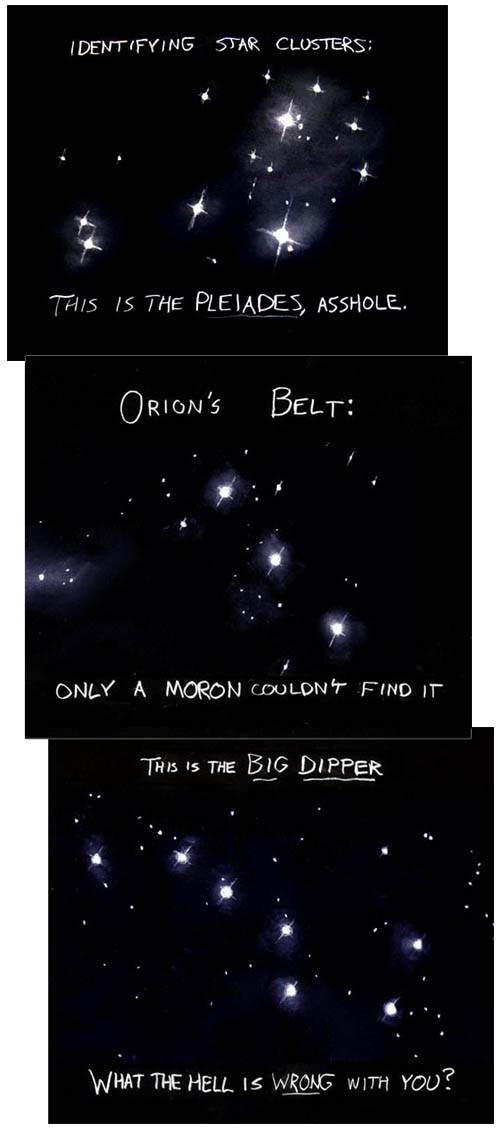Difference between revisions of "66: Abusive Astronomy"
(→Explanation: typo) |
(→Explanation: A small link.) |
||
| Line 13: | Line 13: | ||
When astronomers in the Northern Hemisphere are showing stars to people, there will frequently be someone who points to the Pleiades and says, "There's the Big Dipper!" This gets frustrating about the 100th time that you encounter this error. So, this comic shows someone releasing their frustration on the mis-informed public by pointing out that what they just pointed at is actually the Pleiades. Then, pointing out that you can always locate the Pleiades by following the line of the stars in the belt of Orion. Then, pointing out the REAL Big Dipper. | When astronomers in the Northern Hemisphere are showing stars to people, there will frequently be someone who points to the Pleiades and says, "There's the Big Dipper!" This gets frustrating about the 100th time that you encounter this error. So, this comic shows someone releasing their frustration on the mis-informed public by pointing out that what they just pointed at is actually the Pleiades. Then, pointing out that you can always locate the Pleiades by following the line of the stars in the belt of Orion. Then, pointing out the REAL Big Dipper. | ||
| − | In the title text, Randall explains that he drew this comic as a line drawing on white paper, using only a pencil. The image was later inverted for publication. | + | In the title text, [[Randall]] explains that he drew this comic as a line drawing on white paper, using only a pencil. The image was later inverted for publication. |
==Transcript== | ==Transcript== | ||
Revision as of 20:11, 1 May 2014
| Abusive Astronomy |
 Title text: Medium: Pencil on paper |
Explanation
A constellation is a pattern of stars which form some sort of perceived shape in the night sky. Modern astronomy recognizes 88 unique constellations, but different cultures saw different patterns in the same night sky, going back at least as far as the Babylonians. The Pleiades, Orion's belt and the Big Dipper (formally known as Ursa Major) are among the most common constellations that we recognize today and are among the first taught to people with an interest in astronomy. The Big Dipper is only visible from the Northern Hemisphere and it can be used to help find the north pole star Polaris which is an aid to night-time navigation.
During planetarium tours, the tour guide will point out popular constellations and stars, sometimes they will ask a question to get the audience involved in the presentation. Usually these people are big on showing the wonder of the galaxy and are all smiles, but people have bad days. The comic is presenting an especially aggressive way of introducing the constellations. A sidenote is that the Pleiades, while a famous night-sky object, is not a constellation at all; it is an open star cluster.
When astronomers in the Northern Hemisphere are showing stars to people, there will frequently be someone who points to the Pleiades and says, "There's the Big Dipper!" This gets frustrating about the 100th time that you encounter this error. So, this comic shows someone releasing their frustration on the mis-informed public by pointing out that what they just pointed at is actually the Pleiades. Then, pointing out that you can always locate the Pleiades by following the line of the stars in the belt of Orion. Then, pointing out the REAL Big Dipper.
In the title text, Randall explains that he drew this comic as a line drawing on white paper, using only a pencil. The image was later inverted for publication.
Transcript
- Identifying star clusters:
- [Image of a star cluster.]
- This is the Pleiades, asshole.
- Orion's Belt:
- [Image of Orion's Belt.]
- Only a moron couldn't find it.
- This is the Big Dipper:
- [Image of the Big Dipper.]
- What the hell is wrong with you?
Discussion
Actually, I don't quite get it. Since it's one of the early xkcd strips, it is somewhat different from the latter ones. I would suppose he is making fun on how it is impossible to guess what the constellations are, as they just look like a bunch of stars clumped together (definitely not like a belt). 35.13.220.113 03:52, 25 October 2012 (UTC) NariOX
The first one looks like a certain male part, the second looks like a pencil, I can't figure out the last one though... 98.212.198.105 (talk) 06:36, 6 November 2012 (UTC) (please sign your comments with ~~~~)
Constellations are NOT "formally known as asterisms." They are defined area of the celestial sphere. Asterisms are star formations that are part of constellations (e.g. Orion's Belt) or can span multiple constellations (e.g. the Summer Triangle and Winter Hexagon.) Constellations are more formally called, um, constellations. Subwoofer (talk) 22:23, 6 September 2013 (UTC)
I have been stargazing quite a lot in the last year and I can tell that those constellations are rather simple to recognize in the night sky; especially the Orion's belt, only someone completely inept wouldn't be able to find it, in the Northern Hemisphere. 108.162.219.59 (talk) (please sign your comments with ~~~~)
Never knew about the confusion with Pleiades, always though it was between the Big Dipper and the Little Dipper. -- Flewk (talk) (please sign your comments with ~~~~)
Big Dipper is a Ladle. For taking drinks, perhaps, from the drinking gourd. Referenced from abolitionist movement times. http://pathways.thinkport.org/secrets/gourd1.cfm ((GlitchedOut)) 108.162.245.64 (talk) 17:14, 14 February 2017 (UTC) (please sign your comments with ~~~~)